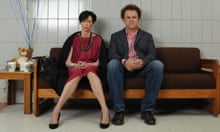If you're unfamiliar with the artist Pipilotti Rist, your first encounter with her work could prove surreal: at the end of this month, to coincide with her major solo exhibition at London's Hayward gallery, she will hang a string of 300 pairs of white underpants along the south bank of the Thames. The pants, in three sizes, will be lit from within to form a bizarre outdoor light sculpture called Hip Lights, one of two new works that Rist has created specially for the Hayward show.
"From a distance," Rist tells me by phone from her studio in her native Switzerland, "they will look like whipped cream. Or sheep's heads, with the legs of the pants forming the eyes. I hope they will make people smile, but also think about the relationship we have with this important, sexually charged area in the middle of our bodies. We all come out from between our mother's legs. From there that we first see the light of the world."
This preoccupation with the body – and the female body in particular – underpins much of her art, which encompasses sculpture, audio and video installations. In her 1996 film I'm Not the Girl Who Misses Much, Rist dances frenetically for the camera, her breasts bare. And in 1992's Pickelporno, lurid images of leaves and flowers are overlaid with erotic closeups of writhing lovers.
These works – together with possibly her best-known video installation, 1997's Ever is Over All, in which a film of a woman smashing car windows with an unexpectedly heavy flower is juxtaposed with tranquil images of exotic blooms – have earned Rist a reputation as a feminist artist. "Politically," she says, "I am a feminist, but personally, I am not. For me, the image of a woman in my art does not stand just for women: she stands for all humans. I hope a young guy can take just as much from my art as any woman."
The exhibition's title, Eyeball Massage, is a reference to Rist's fascination with the power of the moving image. "Film represents both the way the eye works and our subconscious. I love the idea that we can be watching television for two hours, and be aware only of the images we are seeing – not the glass and plastic that is projecting them."
Through all Rist's art runs a vein of humour and unselfconscious positivity that is all too rare in contemporary art. She is happy to be known as an optimist. "Every artist has an agenda," Rist says, "and my agenda is hope. With the world the way it is, that seems particularly important."






